大学英语语法大全
大学英语语法
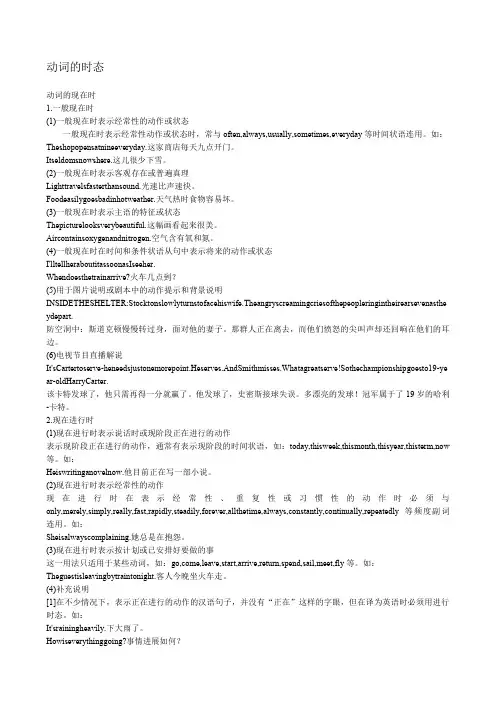
动词的时态动词的现在时1.一般现在时(1)一般现在时表示经常性的动作或状态一般现在时表示经常性动作或状态时,常与often,always,usually,sometimes,everyday等时间状语连用。
如:Theshopopensatnineeveryday.这家商店每天九点开门。
Itseldomsnowshere.这儿很少下雪。
(2)一般现在时表示客观存在或普遍真理Lighttravelsfasterthansound.光速比声速快。
Foodeasilygoesbadinhotweather.天气热时食物容易坏。
(3)一般现在时表示主语的特征或状态Thepicturelooksverybeautiful.这幅画看起来很美。
Aircontainsoxygenandnitrogen.空气含有氧和氮。
(4)一般现在时在时间和条件状语从句中表示将来的动作或状态I'lltellheraboutitassoonasIseeher.Whendoesthetrainarrive?火车几点到?(5)用于图片说明或剧本中的动作提示和背景说明INSIDETHESHELTER:Stocktonslowlyturnstofacehiswife.Theangryscreamingcriesofthepeopleringintheirearsevenasthe ydepart.防空洞中:斯道克顿慢慢转过身,面对他的妻子。
那群人正在离去,而他们愤怒的尖叫声却还回响在他们的耳边。
(6)电视节目直播解说It'sCartertoserve-heneedsjustonemorepoint.Heserves.AndSmithmisses.Whatagreatserve!Sothechampionshipgoesto19-ye ar-oldHarryCarter.该卡特发球了,他只需再得一分就赢了。
他发球了,史密斯接球失误。
大学英语语法汇总
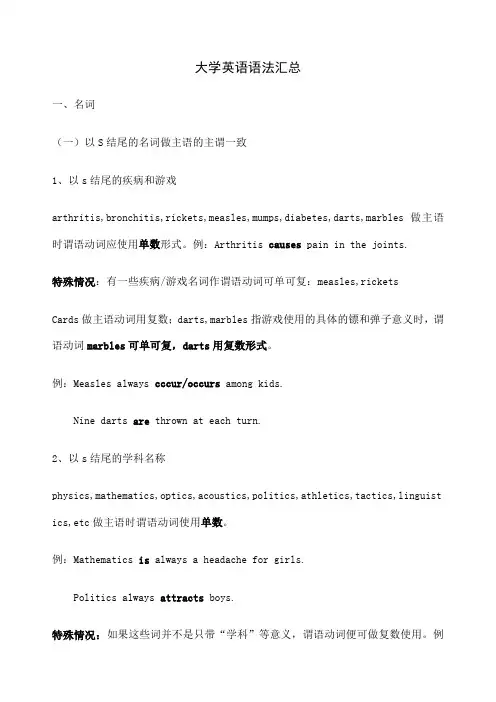
大学英语语法汇总一、名词(一)以S结尾的名词做主语的主谓一致1、以s结尾的疾病和游戏arthritis,bronchitis,rickets,measles,mumps,diabetes,darts,marbles做主语时谓语动词应使用单数形式。
例:Arthritis causes pain in the joints.特殊情况:有一些疾病/游戏名词作谓语动词可单可复:measles,ricketsCards做主语动词用复数;darts,marbles指游戏使用的具体的镖和弹子意义时,谓语动词marbles可单可复,darts用复数形式。
例:Measles always cccur/occurs among kids.Nine darts are thrown at each turn.2、以s结尾的学科名称physics,mathematics,optics,acoustics,politics,athletics,tactics,linguist ics,etc做主语时谓语动词使用单数。
例:Mathematics is always a headache for girls.Politics always attracts boys.特殊情况:如果这些词并不是只带“学科”等意义,谓语动词便可做复数使用。
例如,mathematics运算能力,athletic体育运动,acoustics音响效果,tactics策略,economics经济学意义。
例:The acoustics in Bon Jovi’s Tulsa concert were beyond criticism last spring.3、以s结尾的地理名称The States,the united states,the Netherlands,the Philippines,the United Arab Emirates,the United Nation做主语时,谓语动词使用单数。
大学英语语法总结(全面)
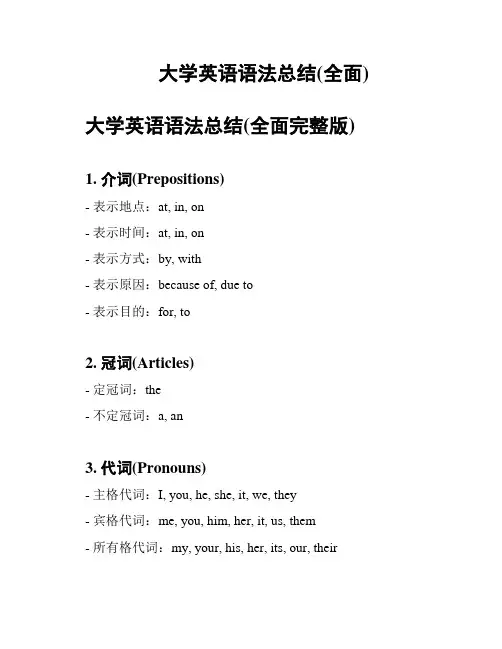
大学英语语法总结(全面)大学英语语法总结(全面完整版)1. 介词(Prepositions)- 表示地点:at, in, on- 表示时间:at, in, on- 表示方式:by, with- 表示原因:because of, due to- 表示目的:for, to2. 冠词(Articles)- 定冠词:the- 不定冠词:a, an3. 代词(Pronouns)- 主格代词:I, you, he, she, it, we, they- 宾格代词:me, you, him, her, it, us, them- 所有格代词:my, your, his, her, its, our, their- 反身代词:myself, yourself, himself, herself, itself, ourselves, themselves4. 名词(Nouns)- 单数名词:book, chair, dog- 复数名词:books, chairs, dogs- 不可数名词:water, money, information5. 动词(Verbs)- 一般现在时:I walk, you walk, he/she/it walks, we walk, they walk- 一般过去时:I walked, you walked, he/she/it walked, we walked, they walked- 现在进行时:I am walking, you are walking, he/she/it is walking, we are walking, they are walking- 过去进行时:I was walking, you were walking, he/she/it was walking, we were walking, they were walking- 一般将来时:I will walk, you will walk, he/she/it will walk, we will walk, they will walk6. 形容词(Adjectives)- 描述名词特征:big, small, tall- 比较级:bigger, smaller, taller- 最高级:biggest, smallest, tallest7. 副词(Adverbs)- 表示方式:quickly, slowly- 表示程度:very, extremely- 表示时间:now, yesterday8. 连词(Conjunctions)- 表并列:and, or- 表递进:furthermore, moreover- 表转折:however, but- 表原因:because, since以上是大学英语语法的简要总结,希望对你有帮助。
大学英语语法(英语专业必看)
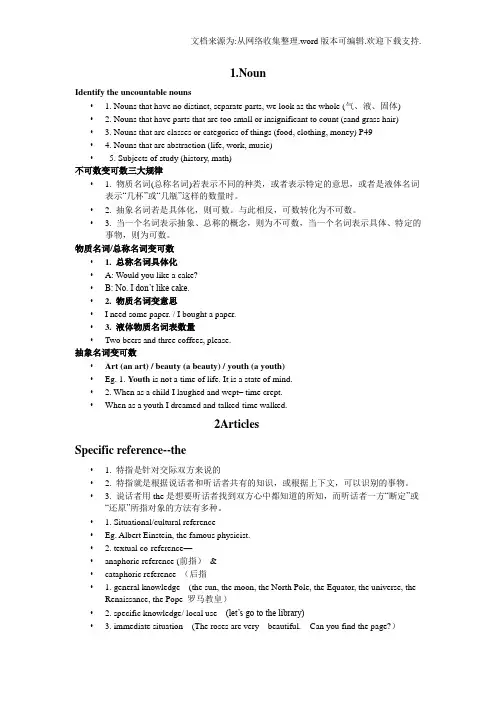
1.NounIdentify the uncountable nouns• 1. Nouns that have no distinct, separate parts, we look as the whole (气、液、固体) • 2. Nouns that have parts that are too small or insignificant to count (sand grass hair)• 3. Nouns that are classes or categories of things (food, clothing, money) P49• 4. Nouns that are abstraction (life, work, music)• 5. Subjects of study (history, math)不可数变可数三大规律• 1. 物质名词(总称名词)若表示不同的种类,或者表示特定的意思,或者是液体名词表示“几杯”或“几瓶”这样的数量时。
• 2. 抽象名词若是具体化,则可数。
与此相反,可数转化为不可数。
• 3. 当一个名词表示抽象、总称的概念,则为不可数,当一个名词表示具体、特定的事物,则为可数。
物质名词/总称名词变可数• 1. 总称名词具体化•A: Would you like a cake?•B: No. I don’t like cake.• 2. 物质名词变意思•I need some paper. / I bought a paper.• 3. 液体物质名词表数量•Two beers and three coffees, please.抽象名词变可数•Art (an art) / beauty (a beauty) / youth (a youth)•Eg. 1. Youth is not a time of life. It is a state of mind.• 2. When as a child I laughed and wept– time crept.•When as a youth I dreamed and talked-time walked.2ArticlesSpecific reference--the• 1. 特指是针对交际双方来说的• 2. 特指就是根据说话者和听话者共有的知识,或根据上下文,可以识别的事物。
大学英语语法PPT(全)
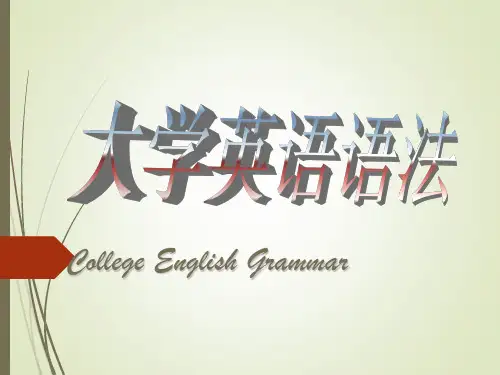
3/4/2023
1、名词(n.): 表示人、事物、地点或抽象概念的名称。如:boy, morning, bag, ball, class, orange.
----《不列颠英语用法大全》
3/4/2023
“语言的科学和艺术” -----英国著名语言学
H.Sweet
3/4/2023
两个目标、三个阶段:
高级阶段
过渡阶段
能
初级阶段
练知↑
由此看出学习语法知识是第一步,通过不断的练习才能实现向语言能力的转 换,最终达到言语交际的目的。
3/4/2023
外语语法学习示意图: 高级阶段 过渡阶段 初级阶段
second, third, fourth. 5、动词(v.): 表示动作或状态。如:am, is,are,have,see . 6、副词(adv.): 修饰动词、形容词或其他副词,说明时间、地点、程度等。如:
now, very, here, often, quietly, slowly. 7、冠词(art..):用在名词前,帮助说明名词。如:a, an, the. 8、介词(prep.): 表示它后面的名词或代词与其他句子成分的关系。如in,
daughter out?
3/4/2023
这位父亲问他女儿的男朋友(其正准 备开车带他女儿出门):Do you drink?他真正的意思是问这个年轻男子 是否有饮酒的习惯,即在询问情况, 而不是问他现在想不想喝酒,即不是 在提议。
3/4/2023
大学英语语法知识点总结
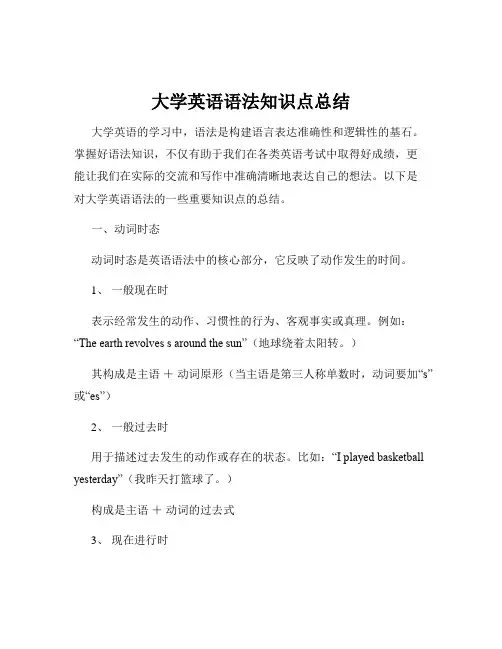
大学英语语法知识点总结大学英语的学习中,语法是构建语言表达准确性和逻辑性的基石。
掌握好语法知识,不仅有助于我们在各类英语考试中取得好成绩,更能让我们在实际的交流和写作中准确清晰地表达自己的想法。
以下是对大学英语语法的一些重要知识点的总结。
一、动词时态动词时态是英语语法中的核心部分,它反映了动作发生的时间。
1、一般现在时表示经常发生的动作、习惯性的行为、客观事实或真理。
例如:“The earth revolves s around the sun”(地球绕着太阳转。
)其构成是主语+动词原形(当主语是第三人称单数时,动词要加“s”或“es”)2、一般过去时用于描述过去发生的动作或存在的状态。
比如:“I played basketball yesterday”(我昨天打篮球了。
)构成是主语+动词的过去式3、现在进行时表示正在进行的动作。
像:“He is reading a book now”(他正在读书。
)结构为:主语+ be 动词(am/is/are)+动词的现在分词4、过去进行时强调过去某个时刻正在进行的动作。
例如:“I was doing myho mework at 8 o'clock last night”(昨晚八点我正在做作业。
)其形式为:主语+ was/were +动词的现在分词5、现在完成时表示过去发生的动作对现在造成的影响或结果,或者过去的动作一直持续到现在。
例如:“I have finished my work”(我已经完成了工作。
)由“主语+ have/has +动词的过去分词”构成6、过去完成时表示过去某一时间或动作之前已经发生或完成的动作。
例如:“By the end of last year, I had learned 5000 words”(到去年年底,我已经学了5000 个单词。
)结构为:主语+ had +动词的过去分词7、一般将来时用以表达将来要发生的动作或存在的状态。
大学英语语法大全—名词的数、性、格
大学英语语法大全名词的数、性、格名词的数1. 名词复数的规则变化形式词尾字母变化方式例词通常情况加-sbird-birds, shop-shops, lake-lakes-ch,-sh,-s,-x,-z加-eschurch-churches, dish-dishes, class-classes, box-boxes辅音字母+y变-y为-i再加-esfactory-factories, fly-flies, family-families, baby-babies-o加-estomato-tomatoes, hero-heroes-f或-fe变-f或-fe为-v再加-esleaf-leaves, thief-thieves, shelf-shelves, knife-knives, life-lives, half-halves有些以-f或-fe结尾的名词复数只加-s,读作/ s /。
如:gulf - gulfs 海湾chief - chiefs 首领proof - proofs 证据roof - roofs 屋顶有些以-y结尾的专有名词的复数直接加-s。
如:Henry - Henrys亨利Mary - Marys 玛丽有些以辅音字母+o 结尾的名词的复数直接加-s。
如:piano - pianos 钢琴memo - memos 备忘录photo - photos 照片solo - solos 独唱有些以字母-o结尾的名词有两种复数形式,可以加-s,也可以加-es。
如:motto - mottos/mottoes 箴言halo - halos/haloes 光环cargo - cargos/cargoes 货物grotto - grottos/grottoes 洞穴以-oo或元音字母加-o结尾的名词只加-s。
如:banboo - bamboos 竹子kangaroo - kangaroos 袋鼠video - videos 电视radio - radios 收音机只有一个/ s /音结尾的名词,复数形式读/ ziz /。
大学英语语法重点
二、may can might could 的异同
1. May / might 事实上的可能 2. Can / could 理论上的可能
The road may be blocked. The road can be blocked. Can he tell a lie? Yes, he may. 3. Not 否定 may /might, 否定的是句子中的主动词。 They may / might not get there on time tomorrow. They can / could not get there on time tomorrow.
三、做状语 –ing/ to
1. In order to, so as to, only to, too…to.., so … as to… 2. 悬垂
Going home, mother cooked a good meal. 3. 独立主格
Weather permitting, we will go for a picnic tomorrow. 4. -ing/-ed 主动 被动
Ought to 与should 基本类似,但强调责任、义务、应该做, 或者逻辑上的必然性时用ought to
As a student you ought to study hard. I think I should try to lose some weight. It is starry tonight; it ought to be a fine day tomorrow.
3. needn’t have done Since the meeting has been canceled, they needn’t
大学英语语法全集
从句
a)主语从句(subject clause)如What I want to say is this(我要说的是这么一点)中的what I want to say。
b)表语从句(predicative clause)如This is what I want to say(这是我要说的)中的what I want to say。
c)宾语从句(object clause)如I have said what I want to say(我说完了我要说的话)中的what I want to say。
d)定语从句(attributive clause)如This is the thing I want to say(这就是我要说的)中的I want to say。
名词的种类
普通名词的种类
1)类名词(class noun)类名词表示人或事物属 于某一类。如:
tractor 拖拉机 panda 熊猫 factory 工厂 teacher 教员 2)集体名词(collective noun)集体名词是一些
人或物的总称。如: class 阶级,班 herd 兽群 crowd 人群 army 军队
句子
从说话人说话的目的来看,句子可分为: a)陈述句(declarative sentence)用来表达一件事,
如: I saw him yesterday.昨天我看见他了。 b)疑问句(interrogative sentence)用来提出疑问, 如: Did you see him yesterday?你昨天见到他了 吗? c)祈使句(imperative sentence)表示恳求、命令 等,如: Please come in.请进来。
3)表语(predicative)它是放在连系动词之后表 示主语的身分或特征的,如I am a student(我 是一个学生)中的student;Our classroom is clean(我们的教室很干净)中的clean。
大学英语语法大全-太经典了.
大学英语语法学习提纲一、词类、句子成分和构词法:1、词类:英语词类分十种:名词、形容词、代词、数词、冠词、动词、副词、介词、连词、感叹词。
1、名词(n.):表示人、事物、地点或抽象概念的名称。
如:boy, morning, bag, ball, class, orange.2、代词(pron.):主要用来代替名词。
如:who, she, you, it .3、形容词(adj..):表示人或事物的性质或特征。
如:good, right, white, orange .4、数词(num.):表示数目或事物的顺序。
如:one, two, three, first, second, third, fourth.5、动词(v.):表示动作或状态。
如:am, is,are,have,see .6、副词(adv.):修饰动词、形容词或其他副词,说明时间、地点、程度等。
如:now, very,here, often, quietly, slowly.7、冠词(art..):用在名词前,帮助说明名词。
如:a, an, the.8、介词(prep.):表示它后面的名词或代词与其他句子成分的关系。
如in, on, from, above, behind.9、连词(conj.):用来连接词、短语或句子。
如and, but, before .10、感叹词(interj..)表示喜、怒、哀、乐等感情。
如:oh, well, hi, hello.2、句子成分:英语句子成分分为七种:主语、谓语、宾语、定语、状语、表语、宾语补足语。
1、主语是句子所要说的人或事物,回答是“谁”或者“什么”。
通常用名词或代词担任。
如:I’m Miss Green.(我是格林小姐)2、谓语动词说明主语的动作或状态,回答“做(什么)”。
主要由动词担任。
如:Jack cleansthe room every day. (杰克每天打扫房间)3、表语在系动词之后,说明主语的身份或特征,回答是“什么”或者“怎么样”。
